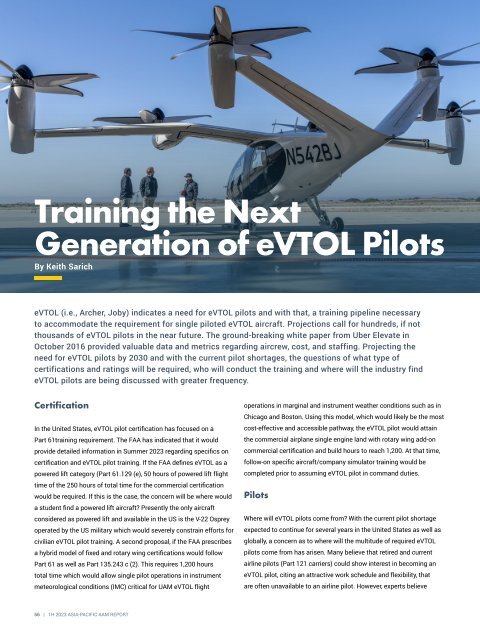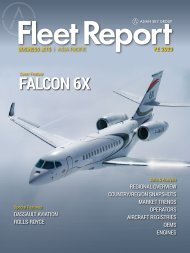Asia-Pacific AAM Report 1H 2023
Create successful ePaper yourself
Turn your PDF publications into a flip-book with our unique Google optimized e-Paper software.
Training the Next<br />
Generation of eVTOL Pilots<br />
By Keith Sarich<br />
eVTOL (i.e., Archer, Joby) indicates a need for eVTOL pilots and with that, a training pipeline necessary<br />
to accommodate the requirement for single piloted eVTOL aircraft. Projections call for hundreds, if not<br />
thousands of eVTOL pilots in the near future. The ground-breaking white paper from Uber Elevate in<br />
October 2016 provided valuable data and metrics regarding aircrew, cost, and staffing. Projecting the<br />
need for eVTOL pilots by 2030 and with the current pilot shortages, the questions of what type of<br />
certifications and ratings will be required, who will conduct the training and where will the industry find<br />
eVTOL pilots are being discussed with greater frequency.<br />
Certification<br />
In the United States, eVTOL pilot certification has focused on a<br />
Part 61training requirement. The FAA has indicated that it would<br />
provide detailed information in Summer <strong>2023</strong> regarding specifics on<br />
certification and eVTOL pilot training. If the FAA defines eVTOL as a<br />
powered lift category (Part 61.129 (e), 50 hours of powered lift flight<br />
time of the 250 hours of total time for the commercial certification<br />
would be required. If this is the case, the concern will be where would<br />
a student find a powered lift aircraft? Presently the only aircraft<br />
considered as powered lift and available in the US is the V-22 Osprey<br />
operated by the US military which would severely constrain efforts for<br />
civilian eVTOL pilot training. A second proposal, if the FAA prescribes<br />
a hybrid model of fixed and rotary wing certifications would follow<br />
Part 61 as well as Part 135.243 c (2). This requires 1,200 hours<br />
total time which would allow single pilot operations in instrument<br />
meteorological conditions (IMC) critical for UAM eVTOL flight<br />
operations in marginal and instrument weather conditions such as in<br />
Chicago and Boston. Using this model, which would likely be the most<br />
cost-effective and accessible pathway, the eVTOL pilot would attain<br />
the commercial airplane single engine land with rotary wing add-on<br />
commercial certification and build hours to reach 1,200. At that time,<br />
follow-on specific aircraft/company simulator training would be<br />
completed prior to assuming eVTOL pilot in command duties.<br />
Pilots<br />
Where will eVTOL pilots come from? With the current pilot shortage<br />
expected to continue for several years in the United States as well as<br />
globally, a concern as to where will the multitude of required eVTOL<br />
pilots come from has arisen. Many believe that retired and current<br />
airline pilots (Part 121 carriers) could show interest in becoming an<br />
eVTOL pilot, citing an attractive work schedule and flexibility, that<br />
are often unavailable to an airline pilot. However, experts believe<br />
56 | <strong>1H</strong> <strong>2023</strong> ASIA-PACIFIC <strong>AAM</strong> REPORT
















